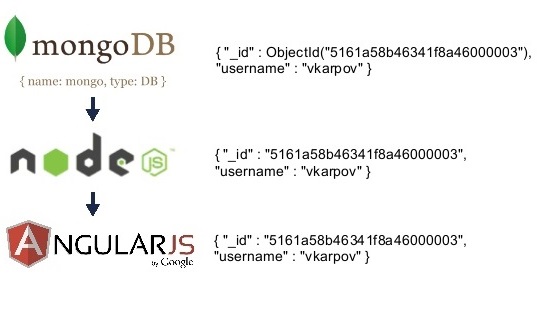
MEAN
is a JavaScript development stack that helps you build fast, robust, and
maintainable production web applications using MongoDB, Express, AngularJS, and
NodeJS.

MEAN stack back-end with MongoDB, ExpressJS and NodeJS.
MEAN stack front-end with AngularJS.
Why do I care?
➤With MongoDB and Mongoose, easy and flexible data validation.
➤With NodeJS, never need threads.
➤With AngularJS, dynamic client-side templates.
Same Language, Same Objects

MEAN Stack Structure
More Information

MongoDB is the leading NoSQL
database, empowering businesses to be more agile and scalable. It’s designed
for storing non-relational data. It’s included in the stack because it’s
queried using JSON and can persist objects as serialized JSON, making it ideal
for JavaScript clients. It’s fast, open-source, flexible and cross-platform
document-oriented database, suited for simpler applications.

Express is a lightweight Node.js web
application framework. Node provides a http module by default but it’s very low
level. Express wraps this up to provide simple get/post methods and other
routing. In the stack, it glues everything together, and it’s also written in
JavaScript. It's providing a robust set of features for building single and
multi-page, and hybrid web applications.

AngularJS is a front end JavaScript framework
developed by Google, UI and client side logic of the stack. The application’s
structure is defined in HTML and extended by AngularJS directives. Control
logic is nicely separated into Controllers which are easy to re-use and
organize. Angular brings a lot to bear in reducing complexity but at the cost
of less control. It provides comprehensive features such as the two-way data
binding, routing, DI of services. It's a
complete solution for rapids and awesome front end development.

Node JS is a platform built on
Chrome's V8 JavaScript engine runtime for easily building fast, scalable
network applications. It uses an event-driven, non-blocking I/O model that
makes it lightweight and efficient. Node is useful as it allows the server to
push to the client over web sockets, helping to create responsive web
applications. It was included in the stack to as it provides the server-side
processing and it’s applications are written in JavaScript. It also brings npm, a package popular package manager, to the party.

great
ReplyDeleteThanks for sharing Awesome blog with us.
ReplyDeleteFull Stack online Training
Full Stack Training
Full Stack Developer Online Training
Thanks for sharing this post.Good one
ReplyDeleteFull Stack Training in Chennai | Certification | Online Training Course| Full Stack Training in Bangalore | Certification | Online Training Course | Full Stack Training in Hyderabad | Certification | Online Training Course | Full Stack Developer Training in Chennai | Mean Stack Developer Training in Chennai | Full Stack Training | Certification | Full Stack Online Training Course
Thanks for the blog. It was worth reading.
ReplyDeletealso,check Full-stack classes in Pune